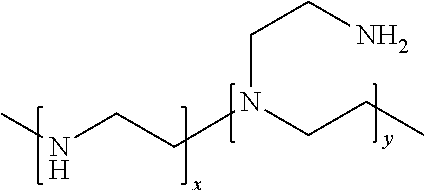Method for Chemical Mechanical Planarization of a Tungsten-Containing Substrate
a technology of chemical mechanical planarization and tungsten, which is applied in the direction of lapping machines, manufacturing tools, other chemical processes, etc., can solve the problems of feature distortion and unsuitability for semiconductor manufacturing, and achieve the effects of increasing tungsten removal rates, and reducing tungsten removal rates
- Summary
- Abstract
- Description
- Claims
- Application Information
AI Technical Summary
Benefits of technology
Problems solved by technology
Method used
Image
Examples
examples
General
[0047]All percentages are weight percentages unless otherwise indicated.
CMP Methodology
[0048]In the examples presented below, CMP experiments were run using the procedures and experimental conditions given below.
GLOSSARY
Components
[0049]Fe-Coated Silica: Colloidal silica at 2.5 wt. % solids level having a particle size of approximately 45 nanometers (nm); the silica particles are coated with iron to an extent such that iron atoms are bound to approximately 25% of the available binding sites on the silica particles.[0050]Medium Size Col Sil: Colloidal silica particles (NexSil 50ZK-DI) supplied by Nyacol, Inc., Ashland, Mass. having an average particle size of approximately 80 nm.[0051]Large Size Col Sil: Colloidal silica particles having an average particle size of approximately 180 nm.[0052]Ethyleneimine, Oligomer Mixture Polyethyleneimine with a minor amount of tetraethylenepentamine[0053](>=5% and [0054]PEI: Polyethyleneimine (Aldrich, Milwaukee, Wis.)[0055]TEOS: tetraethylo...
examples 1-4
[0089]Slurries were made up and tested as shown in Table 1 with slurry pH varying from 2.5 to 4.0. The data in Table 1 show that while pH of the slurry increases from 2.5 to 4.0, the W / TEOS selectivity also increases due to a decrease in TEOS removal rate of 134 A. Also in this pH range, tungsten removal shows a slight decrease as pH of the slurry increases. As the results shown in Table 1, when pH of the disclosed tungsten slurry gradually increased from 2.5 to 4.0, the removal rates of tungsten and TEOS were decreased gradually, the decreased removal rate percentage of TEOS is larger than the percentage of removal rate decrease for tungsten, thus, the selectivity of W / TEOS is increased from 20 to 46 as the pH was changed from 2.5 to 4.0.
TABLE 1Effect of pH on W:TEOS selectivityExampleExampleExampleExample1:2:3:4:pH 2.5pH 3.0pH 3.5pH 4.0Fe-coated colloidal silica0.330.330.330.33(wt %)large-size colloidal silica0.250.250.250.25(wt %)intermediate-size0.150.150.150.15colloidal silica ...
examples 5-7
[0090]Slurries were made and tested with varying hydrogen peroxide concentration as shown in Table 2. The effects of peroxide concentration on the removal rates of tungsten and TEOS and selectivity of W / TEOS are listed in Table 2. When increasing the hydrogen peroxide concentration from 1% to 2, then, to 3%, the removal rates of tungsten were increased by about 43%, and 24%, respectively. The increase of hydrogen peroxide concentrations has almost no effects on the removal rates of TEOS film. The increase of the tungsten removal rates and almost unchanged TEOS removal rates at increased hydrogen peroxide concentrations led to the increase of the selectivity of W / TEOS. The W / TEOS selectivity increased from 12 to 20 as the hydrogen peroxide level was increased from 1 to 3 weight percent.
TABLE 2Effect of hydrogen peroxide concentration on W:TEOS selectivityExampleExampleExample5:6:7:1% H2O22% H2O23% H2O2Fe-coated colloidal silica (wt %)0.330.330.33large-size colloidal silica (wt %)0.25...
PUM
 Login to View More
Login to View More Abstract
Description
Claims
Application Information
 Login to View More
Login to View More - R&D
- Intellectual Property
- Life Sciences
- Materials
- Tech Scout
- Unparalleled Data Quality
- Higher Quality Content
- 60% Fewer Hallucinations
Browse by: Latest US Patents, China's latest patents, Technical Efficacy Thesaurus, Application Domain, Technology Topic, Popular Technical Reports.
© 2025 PatSnap. All rights reserved.Legal|Privacy policy|Modern Slavery Act Transparency Statement|Sitemap|About US| Contact US: help@patsnap.com

